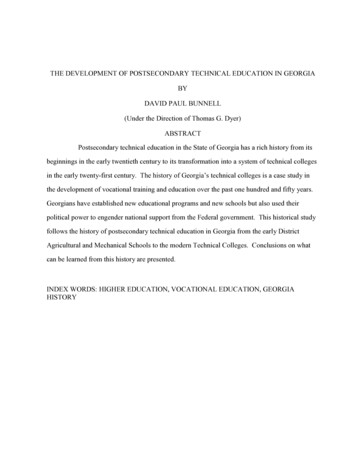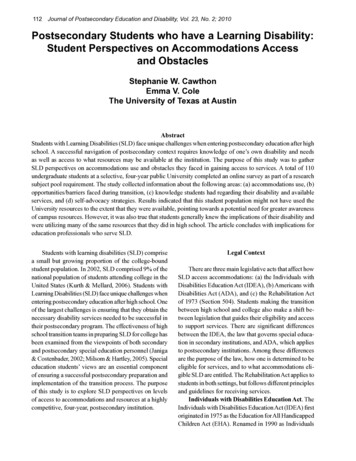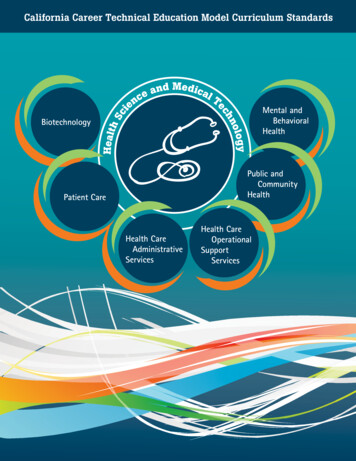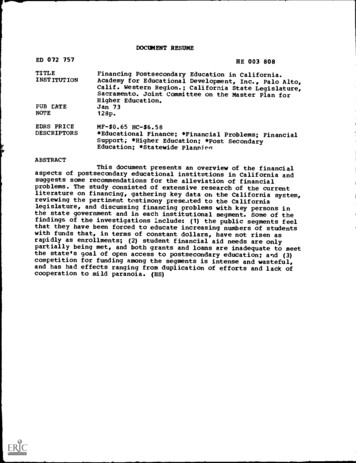
Transcription
THE DEVELOPMENT OF POSTSECONDARY TECHNICAL EDUCATION IN GEORGIABYDAVID PAUL BUNNELL(Under the Direction of Thomas G. Dyer)ABSTRACTPostsecondary technical education in the State of Georgia has a rich history from itsbeginnings in the early twentieth century to its transformation into a system of technical collegesin the early twenty-first century. The history of Georgia‘s technical colleges is a case study inthe development of vocational training and education over the past one hundred and fifty years.Georgians have established new educational programs and new schools but also used theirpolitical power to engender national support from the Federal government. This historical studyfollows the history of postsecondary technical education in Georgia from the early DistrictAgricultural and Mechanical Schools to the modern Technical Colleges. Conclusions on whatcan be learned from this history are presented.INDEX WORDS: HIGHER EDUCATION, VOCATIONAL EDUCATION, GEORGIAHISTORY
THE DEVELOPMENT OF POSTSECONDARY TECHNICAL EDUCATION IN GEORGIABYDAVID PAUL BUNNELLB.A., URBANA UNIVERSITY, 1988M.A., UNITED THEOLOGICAL SEMINARY, 1991M.S.L.S., UNIVERSITY OF KENTUCKY, 1992A Dissertation Submitted to the Graduate Faculty of The University of Georgia in PartialFulfillment of the Requirements for the DegreeDOCTOR OF EDUCATIONATHENS, GEORGIA2009
2009David Paul BunnellAll Rights Reserved
THE DEVELOPMENT OF POSTSECONDARY TECHNICAL EDUCATION IN GEORGIABYDAVID PAUL BUNNELLMajor Professor: Thomas G. DyerCommittee: Libby V. MorrisJ. Douglas TomaDesna L. WallinElectronic Version Approved:Maureen GrassoDean of the Graduate SchoolThe University of GeorgiaDecember 2009
ivDEDICATIONIn Memory ofRuth Ann Nicodemus Bunnell (1938-2004), Ohio Master Teacher and Beloved Mother.
vACKNOWLEDGEMENTSI would like to thank Dr. Thomas Dyer for all his help during the writing and researchprocess. I would also like to thank the library staff at the University of Georgia and GriffinTechnical College for their help in obtaining research materials.I would like to acknowledge my father, Dr. Paul G. Bunnell who instilled in me a deepinterest in higher education and encouraged me as I entered the ―family business.‖ Alsoacknowledgements go to both my sister, Paula Layne, and my best friend at work, Lynn Futral,for putting up with me and my distress calls.Finally, I most sincerely depended on the love and support of my family, most especiallymy wife Wendy S. Wilmoth. Without her constant emotional, spiritual, and intellectual supportover the last few years I never would have made it through.
viTABLE OF CONTENTSACKNOLEDGEMENTS . .vLIST OF TABLES . .viiLIST OF FIGURES . . . viiiCHAPTER1INTRODUCTION .12 PRE-SECOND WORLD WAR VOCATIONAL EDUCATION IN GEORGIA . . 153 POST-WAR DEVELOPMENT OF VOCATIONAL-TECHNIAL EDUCATION INGEORGIA . 524 TRANSFORMTION OF GEORGIA‘S TECHNICAL INSTITUTES INTOTECHNICAL COLLEGES .855 CONCLUSIONS . . 1116 BIBLIOGRAPHIC NOTE . ,. 124BIBLIOGRAPHY . 136
viiLIST OF TABLESTable 1: Technical Colleges in Georgia DTAE (Fall 2001) . 12Table 2: Major Federal Legislation Concerning Vocational-Technical Education . 14Table 3: Status of the District Agricultural and Mechanical Schools (1945) . 41Table 4: Area Vocational-Technical Schools in 1971 . 83Table 5: Georgia Technical Institutes 1990 . 89Table 6: TCSG Merger Plan . 120
viiiLIST OF FIGURESFigure 1: Map of Georgia‘s Technical College . 13Figure 2: DTAE Annual Credit Enrollment (1991-2003). 95Figure 3: Georgia‘s Model for Seamless Education . 107Figure 4: Fiscal Year Enrollment in Georgia Virtual Technical Institute (College). 109
1CHAPTER 1INTRODUCTIONOn July 6, 2000 in Griffin, Georgia, a ceremony took place that included all the townworthies and the staff and students of a small technical school. Griffin Technical Instituteformally changed its name to Griffin Technical College. This name change was the culminationof an evolutionary process for postsecondary technical education in the State of Georgia. CoyHodges, president of the newly named Griffin Technical College would later say, ―There's magicin the name 'college'. It adds prestige and credibility to the school when you have that tackedonto the name.‖1 The search for this credibility has been a hallmark of technical education inGeorgia. For all the men and women who worked toward this day, it was the final step on a longroad.The development of the Georgia Technical College System is not unique, but it isunusual. Georgia‘s development of postsecondary technical education and its exclusivelyvocational nature are uncommon and little studied in historical context. There is no detailedstudy of the development of Georgia's Technical College System. Compared with othersegments of the history of higher education, postsecondary technical and vocational education isnot extensively studied.The term ―technical college‖ first grew up in the first decade of the twentieth centuryand was used to describe a specialized institution whose primary mission was instruction inagriculture science, and industrial and mechanical arts.2 It took eighty years for the technicalbased postsecondary schools in Georgia to take on the title of technical colleges. During thetwentieth century the schools started as district agricultural and mechanical schools became area1"More Students Rush to Georgia's Technical Colleges," Atlanta JournalConstitution, October 8 2000.2A.H. Chamberlain, "The Function and the Future of the Technical College," Science29, no. 749 (1909).
2vocational-technical institutes by the 1960s, evolved into technical institutes through the 1980sand 1990s and finally became technical colleges in 2000. Although, the name has changedthrough the years, the workforce development mission has remained remarkably similar.Postsecondary technical education‘s ability to adapt to the changes in the political movements,the economics, and educational theory changes has become its greatest strength.A study of the history of postsecondary technical institutions is important tounderstanding the forces that shaped the technical colleges and continue to influence their future.The purpose of this dissertation is to describe the history of Georgia‘s technical colleges whilelooking at the decisions and historical forces that shaped the current system. A study of thehistory of the Technical College System of Georgia will help policymakers understand how thepresent state of public higher education, in Georgia evolved and provide insight into its futuredirection and growth.The Technical Colleges System of Georgia (TCSG) consists of thirty-two associatedegree granting technical colleges with thirty-one branch campuses and technical programs atfour Georgia Board of Regents institutions. The TCSG governs the technical colleges andprovides adult education programs and customized business and industry training through itsQuickStart programs.Unlike the Georgia Board of Regents, the TCSG is under the executive control of theGovernor. The Governor appoints the members of the State Board of Technical and AdultEducation. The State Board oversees all operations of the department and appoints aCommissioner. The structure is similar to other state government executive departments such asthe Department of Health and Human Resources.The technical colleges offer two-year associate degrees, one-year diplomas, sixmonth certificate programs, continuing education programs, and economic developmentprograms. The associate degrees are terminal technical degrees that are designed to meet theneeds of local business and industry. Some examples of these programs are automotive
3mechanics, small business management, culinary arts, computer networking, paralegal studies,and a wide variety of allied health programs including licensed practical nursing and radiology.All programs must be able to lead to employment in their area of training and all instructionaldesign includes input from business and industry.The Technical College System of Georgia was the Department of Technical andAdult Education until early 2008. The mission of the system has not yet been rewritten in itsfinal format, but the original mission statement of Department of Technical and Adult Education,now the TCSG, shows the emphasis of economic development and workforce training:The mission of the Department of Technical and Adult Educationis to contribute to the economic, educational, and communitydevelopment of Georgia by providing quality technical education,adult literacy education, continuing education, and customizedbusiness and industry workforce training to the citizens ofGeorgia.3The technical colleges in Georgia play a major supporting role in the stategovernment‘s efforts at economic development. The student population pursuing career andtechnical education in Georgia is extremely diverse. Technical colleges in Georgia servetraditional college-age students preparing for a first job, working adults seeking to retrain for anew job or upgrade existing skills, current employees of local businesses and industries, andolder adults seeking to develop technical skills for personal reasons.The technical colleges are the only educational institutions that are under the directsupervision of the executive branch of Georgia‘s state government. Despite the role of theTCSG Board, the Governor has a great deal of discretion with the technical colleges that is notpossible in either the Georgia Board of Regents or the Georgia Department of Education school3Kenneth H. Breeden, "Foundations and Defining Principles of Georgia's TechnicalCollege System," ed. Georgia Department of Technical and Adult Education (State of Georgia,2002).
4systems. This puts the technical colleges within very strict boundaries and effectively limitstheir development beyond technical and adult education. The strictly vocational mission makesthe technical colleges in Georgia distinct among two-year institutions of higher education in theUnited States.The two-year college is an American invention and developed in response to thediverse educational needs of growing industrial power. The concept of an institution that wouldteach at the freshman and sophomore level started in the late nineteenth century and took root inthe early twentieth century. The ―junior college‖ first arose in 1851 with a proposal from HenryTappan then president of the University of Michigan. His argument was that the burden ofproviding general education should not be on the universities. Tappan looked to the model of theGerman universities where general education was assumed on entrance to the university. Theideal university would concentrate all its resources on advanced research and education at theprofessional level. William Mitchell, a University of Georgia trustee, used this same argumentin 1859 in his proposal for a junior college in Georgia.4William Rainey Harper of the University of Chicago, Edmund J. James of theUniversity of Illinois, and David Starr Jordon of Stanford University all pushed for an even moredirect emulation of the German educational model. The universities would provide higher-orderscholarship and upper-level higher education while the lower-division high schools wouldprovide all general and vocational education up to the age of nineteen or twenty. Harperbelieved that the weaker four-year colleges that had spread so widely throughout the UnitedStates in the mid-1800s should become junior colleges that would feed their graduates into thelarge universities. Harper along with J. Stanley Brown, superintendent of Joliet Township High4William L. Mitchell, ―Programme of an Enlarged Organization of the University ofGeorgia‖, 1859 as found in Thomas Diener, Growth of an American Invention: A DocumentaryHistory of the Junior and Community College Movement, Contributions to the Study ofEducation, (Westport, Conn.: Greenwood Press, 1985).
5School founded Joliet Junior College as the first public two-year institution of higher educationin 1901.The junior college movement expanded rapidly in the first decades of the twentiethcentury. There were 20 junior colleges in the United States in 1909; by 1920 there were 170.Many small four-year colleges became junior colleges. Several states pushed forward the juniorcollege as a way to increase the higher education opportunities for an ever-increasing number ofhigh school graduates. California took an early lead in public junior college development. By1930, California had 20 percent of the public two-year colleges and one-third of the total juniorcollege students. Other states with substantial numbers of public junior colleges were Illinois,Texas, and Missouri.5In Georgia, a few junior colleges were founded over the first half of the twentiethcentury. Many of these junior colleges were private, church-related two-year colleges foundedin predominantly rural areas. By 1950, there were just five public junior colleges under theGeorgia Board of Regents. None of the public junior colleges could be called comprehensivecommunity colleges in the post-war model. The pattern of a dual system of technical educationfor those over sixteen and a postsecondary system of junior colleges, colleges, and universitieswas firmly set.6Following the Second World War a new model of the comprehensive communitycollege developed. The community college was first described in a report written by PresidentHarry S. Truman‘s commission charged with looking at the condition of higher education in5Arthur M. Cohen and Florence B. Brawer, The American Community College (SanFrancisco: Jossey-Bass, 2003).6Cameron Fincher, Historical Development of the University System of Georgia,1932-1990 (Athens, Ga.: Institute of Higher Education University of Georgia, 1991).
6America in 1947. The commission was chaired by George F. Zook and called for many changesin American higher education, including the establishment of public community colleges.7Cohen and Brawer describe the curricular functions of the comprehensive communitycollege as including academic transfer programs, vocational-technical programs, continuingeducation programs, community service, and remedial education.8 Georgia‘s technical collegescover all curricular functions of a comprehensive community college except academic transferprograms. The reason for this is the unusual history of the development of Georgia‘s technicalcolleges from their beginnings as vocational-technical schools.Two-year colleges are classified by the types of academic programs they offer.9Thetraditional junior college usually offers a collegiate student all of his or her academic programfor the fires two years. The course work is designed to transfer to a senior college or university.The traditional technical institute usually offers vocational-technical training and terminaloccupationally oriented diplomas with few if any transferable academic programs. Thecomprehensive community college offers both academic transfer and vocational-technicalprograms. The term technical college is in many ways just a change in nomenclature as opposedto a great change in actual structure of the institution. It does, however, mark a step in movingfrom the gray area between secondary and postsecondary institutions and the acceptance ofpostsecondary technical education as a part of higher education in the United States.There are generally two models for development of public two-year college systemsin the United States. The first is the ―California Idea‖ where the local high school districts7United States. President's Commission on Higher Education. and George FrederickZook, Higher Education for American Democracy, a Report (Washington, D.C.: U.S. Govt.Print. Off., 1947).89Cohen and Brawer.Gwyer Schuyler, "A Curriculum-Based Classification System for CommunityColleges," New Directions for Community Colleges, no. 122 (2003).
7developed postgraduate courses that developed into transferable two-year degree programs.These local high school programs then developed into junior college districts. The local juniorcolleges started offering vocational-technical programs and evolved into community collegesduring the 1950s. The second is the ―Wisconsin Idea‖ where the University of Wisconsin offersextension programs throughout the state that provided primarily academic transfer programs. Aparallel system of vocational-technical schools was developed from postgraduate high schoolsystems.10Georgia follows most closely the ―Wisconsin Idea.‖ The development of Georgia‘svocational-technical schools into technical colleges has been slower than that of Wisconsin, butthe result has been a similar governance structure with two parallel governing boards. The majordifference in the current governance structure between Georgia and Wisconsin is that theGeorgia board is under the executive branch of state government and the Wisconsin governingboard is independent.Georgia‘s technical colleges have developed into postsecondary institutions from theearly twentieth century industrial education and agricultural education movements. Educationhas been recognized as a tool of economic development in Georgia throughout the twentiethcentury. Several terms have been used to describe non-academic education and training inoccupational techniques. Terms used in the early twentieth century included industrialeducation, vocational education, technical education, and occupational education. Thisdissertation will focus on the movements in Georgia to develop institutions for the vocationaland technical education of students who are at least fourteen years old. The movements inagricultural education, home economics, and commercial education are important but have onlytangentially influenced the development of Georgia‘s technical colleges.10Cohen and Brawer.
8In this dissertation, the early foundations of the Technical College System of Georgiaare described from the beginning of the vocational education movement of the early twentiethcentury through the change to technical colleges in the year 2000. The study uses historicalanalysis of archival data, documentary evidence, and interviews to explore the followingquestions regarding the growth and transformation of technical education in Georgia: 1) Whatinfluences brought about the creation of the first vocational-technical schools in Georgia?; 2)What were the causes for the transformation of the vocational-technical schools into technicalinstitutes and subsequently technical colleges?; 3) How do Georgia‘s technical colleges fit intothe larger higher education environment of Georgia?; 4) What does the story of the developmentof technical education in Georgia tell us about its future? In answering these four questions, Iwill rely on the state relative autonomy theory developed by Kevin Daugherty.Over the past twenty years, higher education researchers have studied the―vocationalization‖ of two-year colleges in the United States. There has been a marked trend inall sectors of higher education toward career orientation. This has been shown by the increase inbusiness and professional programs along with a decrease in traditional liberal arts programs.The general pattern of most large two-year colleges has been to increase the number ofvocational-technical programs, most of which are not transferable to senior level colleges anduniversities. The vocationalization of two-year colleges has been explained in many differentways. Theories put forward include a wide-range of social forces that influence educationalpolicy. One extreme includes the theories based on class elitism where two-year colleges act as―cooling out‖ institutions that filter weaker students allowing traditional public colleges anduniversities to have stricter enrollment policies. On the other extreme are the theories based onfunctionalism that emphasize a populist push for a democratic and practical postsecondaryeducation.Community Colleges are an invention of the American higher education system.There is a great deal of literature on the history of the junior and community college movement.
9Several good histories that detail the beginnings of the movement at the turn of the twentiethcentury with the founding of Joliet Junior College by the University of Chicago‘s WilliamRainey Harper in 1901. The original mission of the junior college was to provide the first twoyears of a college education before moving to the senior institution.11In the past few decades, the original mission of the junior college has been changing.Starting with the community college movement after World War II, the most two-year collegeshave taken on an increasing role in vocational, industrial, and technical education.12 This has ledto a controversy about the nature of vocationalization among community colleges.Georgia technical colleges are certainly a large part of the economic development inthe state. The question is whether pressure from local citizens was enough to account for theestablishment of the technical college system in its current form. The twentieth century was atime of transition in Georgia‘s economy. Starting as a primarily rural state with small pockets ofindustry, Georgia developed a strong textile industry, then a manufacturing economy, and is nowin the shift toward a primarily service economy. The nature of the economic change hascertainly influenced the change in vocational education to technical education. As the economychanged, there was political pressure from the local leaders to find a way to employ theircitizens. The testimony to this local political pressure is the rapid acceptance and growth of thearea vocational-technical schools throughout the state.Education and economic development have been issues in Georgia since its foundingas a British colony. Georgia and its agriculture-based economy went through a long period ofadjustment to the industrial age during the second half of the nineteenth century and into theearly twentieth century. Education has been one of the chief tools that economic reformers and1112Ibid.Steven Brint and Jerome Karabel, The Diverted Dream: Community Colleges andthe Promise of Educational Opportunity in America, 1900-1985 (New York: Oxford UniversityPress, 1989).
10political leaders have used to push forward economic change in Georgia.13 Vocational andagricultural education has been of prime interest to Georgia policymakers, northern industrialistslooking to establish industry in the state, and the citizens of Georgia looking for economicopportunity.Kantor describes the great variety of groups that supported vocational education.Businessmen, corporate apologists, efficiency-oriented educators, labor leaders, and both liberaland conservative reformers have promoted vocational and technical education in America.14This pattern is evident in the development of Georgia‘s technical colleges from the firstagricultural and mechanical schools.Diverse groups of government and public education officials driven by their ownindividual motives have determined the development of the Georgia technical colleges.However, there is a common theme among the motives of these individuals. These individualmotives have centered on the idea of government as an instrument of economic development ofGeorgia and vocational and technical education as the best ways to attract business and industryto the state.Each new education and economic reform movement through the late nineteenth andthe twentieth century has had its champion in Georgia. The history of Georgia‘s technicalcolleges is a case study in the development of vocational training and education over the past onehundred and fifty years. Georgians have established new educational programs and new schoolsbut also used their political power to engender national support from the Federal government.This dissertation is structured around three distinct times in the development of vocational andtechnical education in Georgia.13Gavin Wright, Old South, New South: Revolutions in the Southern Economy sincethe Civil War (Baton Rouge, LA: Louisiana State University, 1986).14Harvey A. Kantor, "Work, Education, and Vocational Reform: The IdeologicalOrigins of Vocational Education, 1890-1920," American Journal of Education 94, no. 4 (1986).
11The second chapter of the dissertation is an historical narrative that will concentrateon the legislative and social environments surroundings the Smith-Hughes Act and the formationof the first vocational-technical schools in Georgia. This chapter covers the period from the late1800s up through the end of the Second World War in 1945.The third chapter of the dissertation is a narrative that will examine the period ofgrowth in technology and science education that pushed the vocational-technical schools into theera of the vocational-technical area schools that serve specified regions and were tailor made forthe communities in which they were a part. This period extends from the end of the SecondWorld War through the educational challenges of the 1950s to the beginnings of the vocationaltechnical institutes of the 1960s and into the early 1980s.The fourth chapter of the dissertation is a narrative that will describe the growth ofthe vocational-technical institutes as well as the legislation and various commissions anddepartments that helped mold the institutes into true postsecondary institutions of higherlearning. This period extends from 1982 through to the transformation of the institutes into thecurrent technical college system in 2000.The fifth chapter is a summary of the work and includes conclusions and suggestionsfor further research. The sixth chapter is a literature review including coverage of the history ofthe major educational movements that contributed to the current Georgia technical collegesystem.
12Table 1: Technical Colleges in Georgia DTAE (Fall 2001)College NameAlbany Technical CollegeAltamaha Technical CollegeAppalachian Technical CollegeAthens Technical CollegeAtlanta Technical CollegeAugusta Technical CollegeCentral Georgia Technical CollegeChattahoochee Technical CollegeColumbus Technical CollegeCoosa Valley Technical CollegeDeKalb Technical CollegeEast Central Technical CollegeFlint River Technical CollegeGeorgia Aviation Technical CollegeGriffin Technical CollegeGwinnett Technical CollegeHeart of Georgia Technical CollegeLanier Technical CollegeMiddle Georgia Technical CollegeMoultrie Technical CollegeNorth Georgia Technical CollegeNorth Metro Technical CollegeNorthwestern Technical CollegeOgeechee Technical CollegeOkefenokee Technical CollegeSandersville Technical CollegeSavannah Technical CollegeSouth Georgia Technical CollegeSoutheastern Technical CollegeSouthwest Georgia Technical CollegeSwainsboro Technical CollegeValdosta Technical CollegeWest Central Technical CollegeWest Georgia Technical CollegeBainbridge College *LocationYear Founded FTE ille19842,851Dublin1984844Oakwood19641,359Warner 329Acworth19891,041Rock BainbridgeClayton State University *MorrowCoastal Georgia Community College* BrunswickDalton State College*Dalton*Georgia Board of Regents Institutions with Technical Divisions under DTAE
13Figure 1: Map of Georgia’s Technical College1515Used with permission by the Georgia Department of Technical and Adult Education
14Table 2: Major Federal Legislation Concerning Vocational-Technical 9441946195819611962196319651966196819781990Morrill Act: Establishes the first Agricultural and Mechanical Colleges, first landgrant colleges.Department of Education Act: Establishes agency for collecting data on education inthe states.Hatch Act: Grants to the states for creation of agricultural experiment stations.Second Morrill Act: Empowers the Office of Education to administer support to theland grant colleges.Smith-Lever Act: Establishes the land grant college cooperative extension services.Smith-Hughes Act: First funding for vocational technical schools.Smith-Sears Act: Soldiers rehabilitation and vocational training for veterans.Smith-Bankhead Act: First act to provide funds for literacy education.George-Reed Act: Additional funding for agricultural and home economicseducation.George-Deen Act: Provides funds for improving vocational education in public highschools and vocational technical schools.Servicemen‘s Readjustment Act (G.I. Bill): Omnibus bill providing for college andvocational technical education for veterans of World War II.George-Barden Act: Increases funding for vocational technical education and createsa new formula for distribution of funds to the states.National Defens
THE DEVELOPMENT OF POSTSECONDARY TECHNICAL EDUCATION IN GEORGIA . BY . DAVID PAUL BUNNELL (Under the Direction of Thomas G. Dyer) ABSTRACT . Postsecondary technical education in t










